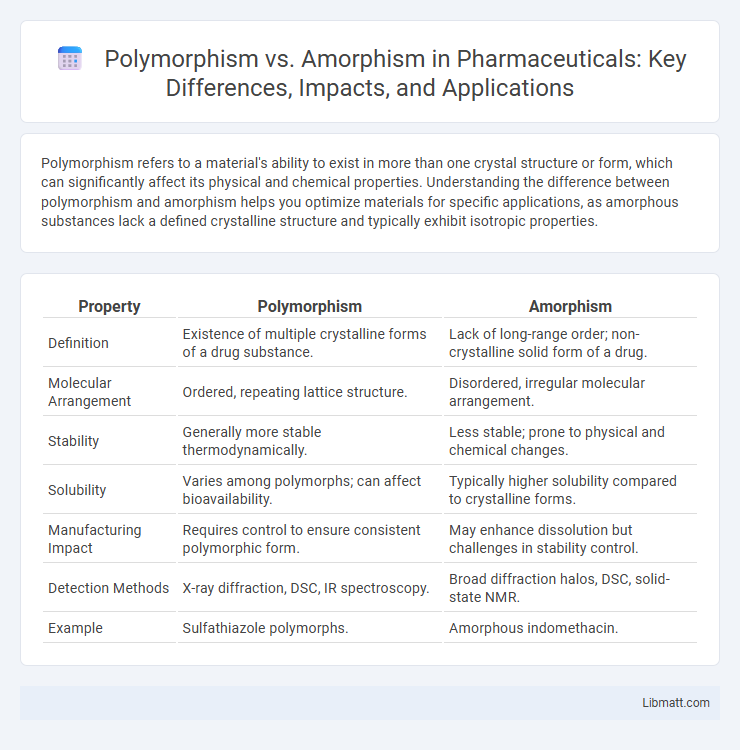Polymorphism refers to a material's ability to exist in more than one crystal structure or form, which can significantly affect its physical and chemical properties. Understanding the difference between polymorphism and amorphism helps you optimize materials for specific applications, as amorphous substances lack a defined crystalline structure and typically exhibit isotropic properties.
Table of Comparison
| Property | Polymorphism | Amorphism |
|---|---|---|
| Definition | Existence of multiple crystalline forms of a drug substance. | Lack of long-range order; non-crystalline solid form of a drug. |
| Molecular Arrangement | Ordered, repeating lattice structure. | Disordered, irregular molecular arrangement. |
| Stability | Generally more stable thermodynamically. | Less stable; prone to physical and chemical changes. |
| Solubility | Varies among polymorphs; can affect bioavailability. | Typically higher solubility compared to crystalline forms. |
| Manufacturing Impact | Requires control to ensure consistent polymorphic form. | May enhance dissolution but challenges in stability control. |
| Detection Methods | X-ray diffraction, DSC, IR spectroscopy. | Broad diffraction halos, DSC, solid-state NMR. |
| Example | Sulfathiazole polymorphs. | Amorphous indomethacin. |
Introduction to Polymorphism and Amorphism
Polymorphism and amorphism are two distinct concepts in materials science, describing different structural arrangements of substances. Polymorphism refers to a material's ability to exist in multiple crystalline forms with varied physical properties, often influencing hardness, melting point, and solubility. Amorphism indicates a lack of long-range order, resulting in an amorphous structure where atoms do not form a repeating pattern, affecting transparency and mechanical strength in materials like glass or polymers.
Defining Polymorphism in Materials Science
Polymorphism in materials science refers to the ability of a solid material to exist in more than one crystal structure or form, while maintaining the same chemical composition. This phenomenon significantly influences the physical properties, stability, and functionality of substances such as pharmaceuticals, metals, and minerals. Understanding polymorphism is crucial for tailoring material properties and optimizing performance in applications like drug formulation and materials engineering.
Understanding Amorphism: Characteristics and Examples
Amorphism refers to the lack of a defined crystalline structure in materials, resulting in disordered atomic arrangements that differ significantly from the organized lattices seen in polymorphic substances. Common examples of amorphous materials include glass, gels, and certain polymers, where the atoms do not form long-range repeating patterns, leading to unique physical properties such as isotropy and variable mechanical strength. Understanding amorphism helps you predict material behavior in applications requiring flexibility, transparency, or irregular molecular organization.
Structural Differences: Polymorphism vs Amorphism
Polymorphism exhibits a highly ordered structure where atoms are arranged in a repeating, crystalline lattice, leading to distinct physical properties such as melting points and densities. Amorphism lacks this long-range order, with atoms distributed randomly, resulting in materials that do not have a defined shape or sharp melting point. Understanding these structural differences enables you to predict material behavior and select appropriate substances for specific industrial or scientific applications.
Formation Mechanisms of Polymorphic and Amorphous Materials
Polymorphic materials form through controlled nucleation and growth processes, where atoms or molecules organize into distinct, repeating crystal lattices under specific temperature and pressure conditions. Amorphous materials arise from rapid cooling or quenching that inhibits atomic mobility, preventing long-range order and resulting in a disordered, non-crystalline structure. Understanding these formation mechanisms is critical for tailoring material properties in pharmaceuticals, ceramics, and semiconductors.
Physical Properties Comparison
Polymorphism and amorphism differ significantly in their physical properties; polymorphic substances exhibit distinct melting points, densities, and crystalline structures due to their ordered molecular arrangements, while amorphous materials lack a well-defined crystal lattice, resulting in variable melting behavior and lower density. Polymorphs often display improved mechanical strength and optical properties because of their uniform atomic organization, contrasting with the isotropic and less rigid nature of amorphous solids. Understanding these physical differences can guide your choice in pharmaceuticals and materials engineering where stability and performance are critical factors.
Impact on Mechanical and Chemical Behavior
Polymorphic materials exhibit distinct crystalline structures that significantly enhance mechanical properties such as hardness, strength, and thermal stability due to their ordered atomic arrangements. In contrast, amorphous materials lack a well-defined crystal structure, resulting in isotropic mechanical behavior with generally lower hardness but increased impact resistance and flexibility. Your choice between polymorphism and amorphism directly impacts chemical behavior, as polymorphic forms often show varied solubility and reactivity, while amorphous forms display higher diffusivity and typically greater chemical uniformity.
Applications in Pharmaceuticals and Industry
Polymorphism in pharmaceuticals influences drug solubility, bioavailability, and stability, making it crucial for optimizing therapeutic efficacy and manufacturing processes. Industries such as pigments, explosives, and food additives leverage polymorphic forms to tailor material properties like color, melting point, and mechanical strength for specific applications. Amorphous materials, characterized by their disordered structure, are used in pharmaceuticals to enhance drug solubility and dissolution rates and in industries like glass production and plastics for improved flexibility and transparency.
Analytical Techniques for Identification
Polymorphism and amorphism are distinguished using analytical techniques such as X-ray diffraction (XRD), which identifies crystal lattice structures characteristic of polymorphs, while amorphous materials show broad, diffuse patterns. Differential scanning calorimetry (DSC) measures thermal transitions like melting points, revealing polymorph-specific endothermic peaks versus the lack of sharp melting in amorphous substances. Infrared spectroscopy (FTIR) and solid-state nuclear magnetic resonance (NMR) provide molecular-level insights into structural order, aiding differentiation by detecting distinct vibrational or magnetic environments typical of polymorphic forms.
Future Perspectives and Advancements
Future perspectives in polymorphism emphasize the development of adaptive materials with tunable properties for applications in pharmaceuticals and electronics, driven by advances in computational modeling and machine learning. Amorphism research is progressing towards stabilizing amorphous states to enhance solubility and bioavailability in drug delivery systems, leveraging novel formulation techniques and characterization tools. Emerging technologies aim to integrate polymorphic and amorphous forms to create hybrid materials with optimized performance and stability.
Polymorphism vs Amorphism Infographic

 libmatt.com
libmatt.com